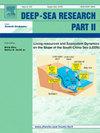The influence of aeolian input on the trace and rare earth element composition of Oligocene-Miocene corals of KOKO Guyot (Emperor seamount chain, Pacific Ocean)
Abstract
The Hawaiian–Emperor Seamount Chain is composed of seamounts capped with fossil coral reef deposits that originally formed close to sea level but are now covered by hundreds of meters of water owing to prolonged subsidence. These fossil reef deposits are important archives of paleoenvironmental change and retain possible traces of Aeolian input from continental Asian dust. We studied the trace and rare earth element composition of Oligocene-Miocene coral reef limestone of Koko guyot aged 25–6 Ma to assess the influence and possible increase of continental allothigenic material input that could persist in marine carbonates. The composition of trace and rare earth elements of modern coral and ancient limestones demonstrated that they had inherited the composition of sea water. Positive europium anomaly observed in modern coral and calcified echinoid spines aged 0–50 thousand years was absent in ancient limestones. This effect could be associated with a change in the oxidation state during diagenesis and recrystallization, which probably led to the loss of europium. The distribution of trace and rare earth elements was constant in carbonate rocks of different ages despite the increase of aeolian input, which confirmed the earlier conclusions about the restriction of incorporation of certain elements into the crystal lattice of carbonate minerals, and demonstrated the regulating role of seawater. In addition, trace and rare earth elements, even if they were adsorbed on the thin films of biological objects during their life, obviously didn't persist there after burial.

 求助内容:
求助内容: 应助结果提醒方式:
应助结果提醒方式:


